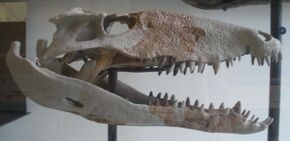Biology:Sebecidae
| Sebecids | |
|---|---|

| |
| Skull of Sebecus icaeorhinus | |
| Scientific classification | |
| Missing taxonomy template (fix): | Archosauria/Reptilia |
| Clade: | Pseudosuchia |
| Clade: | Crocodylomorpha |
| Clade: | Crocodyliformes |
| Suborder: | †Notosuchia |
| Clade: | †Sebecosuchia |
| Clade: | †Sebecia |
| Family: | †Sebecidae Simpson, 1937 |
| Subgroups | |
| Synonyms | |
| |
Sebecidae is an extinct family of prehistoric terrestrial sebecosuchian crocodylomorphs, known from the Late Cretaceous and Cenozoic of Europe and South America. They were the latest surviving group of non-crocodilian crocodylomorphs.
The oldest known member of the group is Ogresuchus furatus known from the Upper Cretaceous (Maastrichtian) Tremp Formation (Spain ).[2] Other records of the group are known from the Eocene of Europe.[3] Sebecids were diverse, abundant and broadly distributed in South America (mostly in Argentina , Brazil and Bolivia) during the Cenozoic, from the Paleocene until the Middle Miocene;[4] although it has been suggested that at least some forms could have survived until the Miocene-Pliocene boundary in Brazil.[5]
This group included many medium- and large-sized genera, from Sebecus to the giant 6-metre-long (20 ft) Barinasuchus from the Miocene.[6]
Phylogeny
The following cladogram simplified after Diego Pol and Jaime E. Powell (2011).[4]
| Sebecosuchia |
| ||||||||||||||||||||||||||||||||||||||||||||||||||||||||||||||||||||||||||||||
References
- ↑ Martin, J. E.; Pochat-Cottilloux, Y.; Laurent, Y.; Perrier, V.; Robert, E.; Antoine, P.-O. (2023). "Anatomy and phylogeny of an exceptionally large sebecid (Crocodylomorpha) from the middle Eocene of southern France". Journal of Vertebrate Paleontology: e2193828. doi:10.1080/02724634.2023.2193828.
- ↑ Sellés, A. G.; Blanco, A.; Vila, B.; Marmi, J.; López-Soriano, F. J.; Llácer, S.; Frigola, J.; Canals, M. et al. (2020). "A small Cretaceous crocodyliform in a dinosaur nesting ground and the origin of sebecids". Scientific Reports 10 (1): Article number 15293. doi:10.1038/s41598-020-71975-y. PMID 32943663. Bibcode: 2020NatSR..1015293S.
- ↑ Martin, Jeremy E.; Pochat-Cottilloux, Yohan; Laurent, Yves; Perrier, Vincent; Robert, Emmanuel; Antoine, Pierre-Olivier (2022-10-28). "Anatomy and phylogeny of an exceptionally large sebecid (Crocodylomorpha) from the middle Eocene of southern France" (in en). Journal of Vertebrate Paleontology 42 (4). doi:10.1080/02724634.2023.2193828. ISSN 0272-4634. https://www.tandfonline.com/doi/full/10.1080/02724634.2023.2193828.
- ↑ 4.0 4.1 Diego Pol and Jaime E. Powell (2011). "A new sebecid mesoeucrocodylian from the Rio Loro Formation (Palaeocene) of north-western Argentina". Zoological Journal of the Linnean Society 163: S7–S36. doi:10.1111/j.1096-3642.2011.00714.x.
- ↑ Liccardo, Antonio, and Luiz Carlos Weinschütz. "Registro inédito de fósseis de vertebrados na Bacia Sedimentar de Curitiba (PR) ." Revista Brasileira de Geociências 40.3 (2010): 330-338.
- ↑ Salias-Gismondi, R.; Antoine, P. O.; Baby, P.; Brusset, S.; Benammi, M.; Espurt, N.; de Franceschi, D.; Pujos, F. et al. (2007). Middle Miocene Crocodiles From the Fitzcarrald Arch, Amazonian Peru. Instituto Geológical y Minero de España. p. 4. ISBN 978-84-7840-707-1. http://www.igme.es/4empsla/libro/62.pdf. Retrieved May 12, 2010.
Wikidata ☰ Q149521 entry
 |

